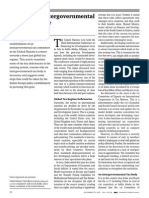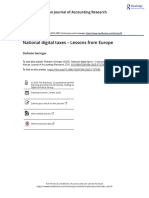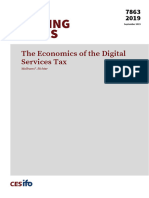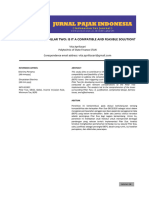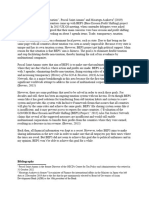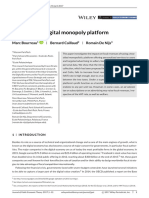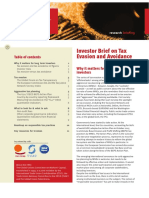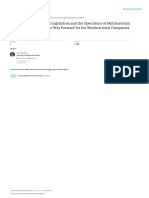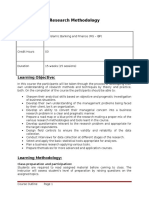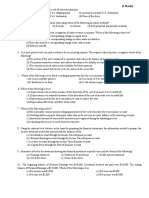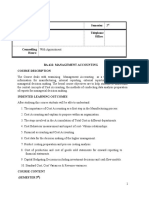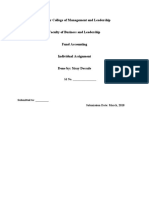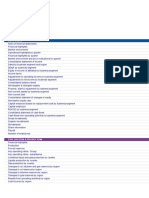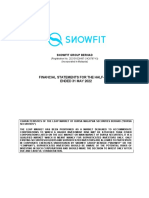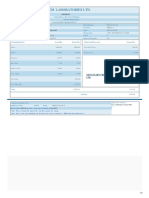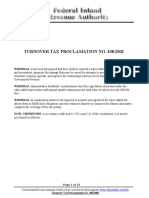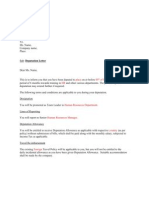Copenhagen Business School Law: Research Paper Series No. 20-16
Copenhagen Business School Law: Research Paper Series No. 20-16
Uploaded by
RazzaqeeeCopyright:
Available Formats
Copenhagen Business School Law: Research Paper Series No. 20-16
Copenhagen Business School Law: Research Paper Series No. 20-16
Uploaded by
RazzaqeeeOriginal Description:
Original Title
Copyright
Available Formats
Share this document
Did you find this document useful?
Is this content inappropriate?
Copyright:
Available Formats
Copenhagen Business School Law: Research Paper Series No. 20-16
Copenhagen Business School Law: Research Paper Series No. 20-16
Uploaded by
RazzaqeeeCopyright:
Available Formats
Copenhagen Business School
Law Research Paper Series No.
20-16
Special issue I:
International Tax Challenges
for Developing Countries
Less is More
- Can Developing Countries Gain Tax
Revenue by Giving up Taxing Rights?
Jeroen Lammers
Electronic copy available at: https://ssrn.com/abstract=3669117
LESS IS MORE
CAN DEVELOPING COUNTRIES GAIN TAX REVENUE BY GIVING UP TAXING RIGHTS?
7 August 2020
Updated version of https://ssrn.com/abstract=3630466
Jeroen Lammers
External PhD candidate University of Amsterdam and Copenhagen Business School
ABSTRACT
The international debate on tax avoidance lately is focused on digital business models. In the
G20/OECD Inclusive Framework on BEPS 137 countries are currently developing the so-called Unified
Approach to address the tax challenges arising from the digitalization of the economy. The aim of
this paper is to examine the possible effects of the separate elements of the Unified Approach on tax
revenue and investment levels for developing countries. The findings show that all the proposals are
highly technical and would require much in terms of capacity of developing countries. Moreover, the
extra tax revenue for developing countries is rather modest, certainly from some of the more
complex proposals. This paper therefore suggests a number of alternate policy options to
significantly reduce complexity, while ensuring developing countries gain the same or more in extra
tax revenue. Moreover, one suggested alternative could effectively reduce harmful tax competition
and prevent future tax disputes.
1. Introduction
The OECD has been working on addressing the tax challenges arising from the digitalization of the
economy for some time. The OECD has identified that the current international tax rules allow for
(primarily) digital business models to provide services to clients in market jurisdiction without having
to pay any profit tax in those jurisdictions 1. And, thus, that the current international tax rules lead to
a situation where certain business models are not subject to appropriate levels of taxation in each
jurisdiction in which they are active (OECD 2019b, para 28).
The OECD has developed the Unified Approach to address this issue. This approach consists of a
number of proposals that aim to fulfil overall key objectives, such as:
Give market jurisdictions access to significantly more tax revenue
Ensure that digital companies are adequately taxed
Ensure that multinational corporations cannot avoid appropriate levels of taxation by
moving activities to jurisdictions with very low tax rates
Restore the level playing field between internationally and locally operating companies
Provide greater tax certainty
1The current rules require some kind of physical presence in a jurisdiction in order for that jurisdiction to have the right to
tax profits.
Electronic copy available at: https://ssrn.com/abstract=3669117
2
The OECD has released a number of documents outlining these proposals, put out two public
consultations to invite comments on the approach and has hosted a number of public consultation
meetings and webcasts as the proposals are developed further. There has been a lot of public
interests in these proposals. This is attested by the fact that thousands of pages of commentary have
been received by the OECD on the public consultations, as well as that many commentators have
written about these proposals in scientific journals, mainstream media and social media.
Remarkably, however, there are very few, commentators among these that have asked a very
fundamental question: do these proposals actually deliver on the stated key objectives? Instead
most of these commentators focused on the technical (legal) details of the proposals, whether or
not they could be applied in practice, if it would lead to double taxation and/or increased
uncertainty etc. All very relevant issues, but perhaps rather moot points should the proposals fail to
deliver on their very raison d’être.
Recently I have argued that at least Amount A, arguably the most radical and without a doubt the
most discussed proposal of the Unified Approach, does not give market jurisdictions access to
significantly more tax revenue (Lammers 2020). This paper intents to build on that research by
extending the analysis to all the separate proposals of the Unified Approach and, at the same time,
focusing on the effects of the Unified Approach for developing countries in particular. This paper
focuses on developing countries, because the corporate tax receipt is especially important to them
and they have arguably been affected most by corporate tax avoidance practices (UNCTAD 2015,
200). Besides, for the international tax system to function, also developing countries have to be able
to apply the (new) rules to determine where corporate profits should be taxed. And they already
have enough problems with the system as it is now and certainly do not need or have the capacity to
deal with additional complexities (Cooper et al 2017, 9).
One could argue that it is still very early to look at the effects of the proposals as the proposals are
not yet fully fleshed out. That it is more important at this stage to develop the legal framework and
work out the exact details and parameters of the proposals. However, IMF has recently warned that
policy decisions of the significance to the international tax system, such as the Unified Approach,
should not be made without any real understanding of the likely consequences (Beer et al 2020, 42).
Moreover, at this point it is very difficult to access the relevant data needed to really help to gain
insight in these likely consequences. So, to determine if the direction of travel is the right one, it is
very important to let the iterative development of the legal framework go hand in hand with the
improvement of understanding of its effects.
In this respect it is also relevant to note that the discussions on the Unified Approach in the
G20/OECD Inclusive Framework are affected by the Covid-19 pandemic. On the one hand, there is a
delay as discussions can only be held online and the originally planned G20/OECD Inclusive
Framework meeting in Berlin on 1-2 July (OECD no date a) cannot take place (OECD 2020c). On the
other hand, there is pressure to speed up the process as the possible extra tax revenue from the
Unified Approach could compensate for increased deficits due to the emergency Covid-19 measures
(Tax Policy Center 2020). As a result, all is now aimed at reaching a political decision at the
G20/OECD Inclusive Framework meeting in the beginning of October, before the G20 Finance
Minister’s meeting takes place on 15 and 16 October in Washington DC. The question is if this mad
dash to the finish line is in the best interest of developing countries. Not in the least, because
especially the developing countries will face huge challenges battling the Covid-19 outbreak with
very limited resources (UNCTAD 2020, 5-6).
Electronic copy available at: https://ssrn.com/abstract=3669117
3
2. Aim, research approach and key findings
The aim of this paper is to examine what the societal impact of the OECD Unified Approach to
address the tax challenges of the digitalization of the economy could be for developing countries, in
particular the effects on tax revenue and investments levels. To this end, the possible effects on tax
revenue for developing countries of the proposals of the Unified Approach are examined 2, both
separately and in connection to each other. This analysis should help to provide insight in the
question if the Unified Approach is indeed the best policy solution for developing countries in
relation to the overall objectives, or that other avenues to get more (tax) revenue might be much
more advantageous to developing countries.
In exploring these other avenues, profit taxation does not necessarily need to be the only answer for
developing countries for more revenue. Even though the corporate income tax receipt is an
important source of income for developing countries other revenue sources 3 should not be
overlooked. For instance, one could argue that developing countries are cheated out of about 300
billion USD every year because of two reasons.
One is that foreign direct investors avoid an estimated 100 billion USD in profit taxation by diverting
their investments through offshore investment hubs (UNCTAD 2015, 200). 4 The other reason is that
advanced economies have failed to honour their commitments regarding development aid.
Advanced economies have promised as far back as 1972 to offer 0.7% of their GNI in Official
Development Assistance (ODA) by 2015 (UN no date a). In 2019 only 6 advances economies have
actually realised this goal (OECD no date b). The total shortfall in 2019 of all 45 advanced economies
together amounts to 191 billion USD (UN no date b).
2.1. Research Approach
As pointed out above, this paper does not mean to test the legal framework of the Unified
Approach, but rather it attempts to chart its effects. The reason for this perspective is that these
effects are really rather underexposed in the current policy debate, while they arguably are
instrumental for getting the proposed changes to international tax policy right.
To make a proper assessment of the societal impact of the OECD proposals access to sufficient and
reliable data is necessary. However, the relevant quantitative data is very often not publicly
available. This is in part due to the fact that the policy discussions on the exact parameters of the
proposals are still ongoing and in part because necessary firm-level data is often thought to be
proprietary in nature and therefore not readily accessible. Consequently, the official OECD
documentation on the Unified Approach (OECD 2019a, 2019b, 2020a), the OECD webcasts (OECD
2020b, 2020c) and the lion’s share of reactions by various commentators (OECD 2019c) are all quite
qualitative in nature.
Given this problem with data-availability, this paper adopts a pragmatic research approach
combining different types of research; (i) A logical approach by looking at the coherence of the rules
of the Unified Approach from both an advanced economy and developing country perspective.
(ii) An evaluative approach by examining if the OECD proposals, both separately and in connection to
each other, can work in practice taking into account differences between advanced economies and
2 Specifically, the effects of Amount A, Amount B of Pillar One, and the Income Inclusion rule and the undertaxed Payments
of Pillar Two.
3 These could also include other types of taxation, however in this paper I will not reflect further on other taxes as
alternative revenue sources
4 This estimate only concerns tax avoidance and does not include other causes of revenue loss, such as corruption or tax
evasion. Even though these illicit activities could lead to huge sums of lost revenues, such illegal activities is outside the
scope of this paper.
Electronic copy available at: https://ssrn.com/abstract=3669117
4
developing countries. As well as examining if the proposals are in line with the overall objectives, the
desired political aim and looked-for economic effects. And (iii) an empirical approach aimed at
finding the best (legal) means to achieve the OECD overall objectives and thus suggesting a number
of alternative policy options that could be explored instead of/in addition to the OECD proposals.
In order to quantify the effects of the OECD Unified Approach this paper relies on a number of
objective data sources, such as the databases and research of OECD, World Bank, IMF and the
United Nations. So, no own data has been collected for this paper through, for instance, surveys or
questionnaires 5. Where no publicly available data could be found to directly quantify the effects, or
where that data is lacking in level of detail, approximations have been made based on the combined
data from these public sources as well as a number of reasoned assumptions. It is clearly indicated in
the paper where such estimates have been made and what they are based on. Moreover, through
either deductive or inductive reasoning a secondary approach has been used where possible to test
if the initial assumptions and their subsequent conclusions can hold.
By way of example, in order to assess the tax revenue impact of Amount A estimates are necessary
to determine how much of the reallocated profit would go to market jurisdictions that are advanced
economies and which share is distributed to developing country markets. A proper assessment
would require insight in firm-level data on the relevant sales of digital services in developing
countries. By way of proxy these relevant sales have been estimated based GDP levels of advanced
economies in relation to developing countries 6. Likewise, to properly assess the tax revenue impact
of Amount B would require insight in a large enough sample of firm-level transfer pricing
documentation to determine the intra-group spending on marketing and distribution services. As
these data are not available, they have been deduced from data on global corporate spending on
these services.
The use of these kind of proxies inevitably means that the calculations in this paper are subject to a
rather large degree of uncertainty. The presented results, even though they are quantified in order
to give more insight in the implications of (the separate elements of) the Unified Approach for
developing countries, should be understood as such.
2.2. Key findings
The Unified Approach proposals could allow developing countries to collectively recover a total
amount of extra tax revenue somewhere in the range of 15 to 30 billion USD. The presented range is
so wide, because the key parameters of all the separate proposals are still under discussion and
certain assumptions have to be made as essential (firm-level) data is not publicly available. In any
event, it is not an insignificant amount.
The analysis in this paper shows that there are big differences per measure in both their revenue
effects and their degree of complexity. Moreover, it shows that if the total amount of extra tax
revenue for the developing world is translated in extra revenue for individual developing countries
the revenue effects appear to be rather modest.
There are strong indications that specifically Amount A will not yield a significant amount in extra tax
revenue to (individual) developing countries, especially not if one factors in the complexity of the
5 The findings in this paper could however be the jumping off point for further research that would include more in-depth
data collection directly from multinational corporations and/or cross-referencing with data that tax authorities should have
(exclusive) access to.
6 It is fully acknowledged that GDP might be a poor indicator to determine relevant sales, as it can be artificially elevated in
low tax jurisdictions relative to the size of the market and therefore could distorting results. For that reason, also trade
levels, the developing countries’ share in world exports of goods and services and that total MNC assets in developing
countries have been considered as a proxy for determining relevant sales.
Electronic copy available at: https://ssrn.com/abstract=3669117
5
new rules and how many (additional) resources it would require for developing countries to
correctly administer them. So, perhaps developing countries should flat-out reject amount A as too
complicated for too little extra tax revenue and push the G20/OECD Inclusive Framework towards a
solution that has amount B as a much more central element 7, as this proposal is potentially more
interesting for developing countries as well as easier to apply.
There is, however, remarkably little data available on Amount B. It could also be that Amount B does
not quite deliver significantly more tax revenue to developing countries either and/or that applying
Amount B would also be far from easy. Whether or not Amount B will prove worthwhile, hinges very
much on the negotiations on the technical specifications and parameters currently underway in the
Inclusive Framework. Specifically, on the question what the fixed renumeration of marketing and
distribution services will be. This renumeration needs to be quite a bit higher than the current
transfer pricing rules allow for, if Amount B is to be of real interest to developing countries.
Finally, given the current state of play one could expect that the final design of Pillar Two could be
such that it (i) is aimed more at protecting the tax base of residence countries than that of source
countries (Keen et al 2019, para 53) and (ii) will be complex due to the chosen level of blending
(OECD 2020a, para 11) 8. Moreover, the amount of extra revenue is very dependent on the level of
the effective minimum tax rate. Consequently, further work in the Inclusive Framework on these
issues could also make Pillar Two lose its appeal for developing countries.
Given these uncertainties, it could serve developing countries’ interest to argue for a third option.
One that effectively bypasses both Pillar One and Pillar Two obligations altogether. Moreover, both
developed and developing countries could benefit from a solution that ensures that also developing
countries can effectively apply the new rules.
This could be achieved by proposing that in-scope companies can opt to consolidate all their
activities in the market jurisdiction into the residence country and consequently award a fixed
percentage of the total consolidated tax revenue (rather than then a part of the tax base) to the
market jurisdictions. Thus, developing countries could actually gain corporate tax revenue by giving
up taxing rights to residence countries.
In any event, developing countries could push for wide support for a global Marshall Plan to help
countries fight and recover from the Covid-19 pandemic. This could, at least, ensure that the current
shortfall will not grow even larger as also many advanced economies face growing deficits as a result
of emergency measures to combat Covid-19. And it could conceivably (temporarily) increase the
contributions that advanced economies provide in ODA, for instance through the forgiveness of
government debts. Such a measure would, in fact, not actually increase government expenditure
levels for donor countries but would help developing countries greatly in bolstering their financial
position and, thus, increase their ability to combat the pandemic and the fall-out afterwards.
7 One could question if developing countries can really influence the outcome of the OECD/Inclusive Framework
negotiations. The OECD has many times expressed that all countries in the Inclusive Framework operate on an equal
footing. In 2017 the OECD explained how the Inclusive Framework is designed and what the phrase on equal footing means
and how the decision process takes form. So, on paper developing countries in the Inclusive Framework can contribute in
the consensus-based decision-making process as much as any other country can. I can offer no objective, empirical
evidence that this does not also work like this in practice. It can, however, be observed that the issues raised by countries
such as the US appear to be more prominent in the discussions than the issues this paper addresses.
8 This refers to discussion in the G20/OECD Inclusive Framework whether the effective tax rate has to either be calculated
on the global level, the level of a single jurisdiction or per separate entity. The discussion tends towards blending on the
level of the jurisdiction.
Electronic copy available at: https://ssrn.com/abstract=3669117
6
3. Show them the money! 9
Total government revenues of developing countries amounted in 2012 to about 6,9 trillion USD
(UNCTAD 2015, 185). About half of that stems from corporate contributions. The other half comes
from personal income taxes, indirect taxation and other revenue sources, such as concessions,
grants and also development aid. The latter category is often overlooked in tax studies but is very
relevant for developing countries: also, in terms of missed revenue.
3.1. Advanced economies miss own ODA target by 191 billion USD
The best-known target for international aid is that donor countries offer 0.7% of their Gross National
Income (GNI) in Official Development Assistance (ODA) (OECD no date a). In the UN Resolution of 24
October of 1970, the following commitment was assumed:
“Each economically advanced country will progressively increase its official development
assistance to the developing countries and will exert its best efforts to reach a minimum net
amount of 0.7% of its gross national product at market prices.” (UN no date a)
At subsequent UN conferences and other international summits many developed countries
reaffirmed they would hit the target by 2015. For instance, in 2005 the EU Member States pledged
to increase ODA to 0.7% of GNI by 2015 and included an interim target of 0.56% by 2010. The EU
Heads of State and Government reaffirmed their commitment to reach the 0.7% target by 2015 at
the European Council on 7/8 February 2013 (European Commission 2013).
It is common knowledge that the target has not been hit yet. The margin by which countries have
missed the mark is however quite astonishing. The gap is now a whopping 191 billion USD (UN no
date b). In fact, figure 1 shows that on average the ODA contributions have fallen since 1960. Not
only did economically advanced economies not live up to their repeatedly given commitments,
collectively they are falling short further and further. There are only 6 countries (out of 45) that
contribute more than 0.7% of their GNI 10.
Figure 1
Source: (OECD no date b)
9 Based on the line spoken by the character Rod Tidwell, played by Cuba Gooding, Jr., in the film Jerry Maguire, directed by
Cameron Crowe (1996).
10 These countries are Denmark, Luxembourg, Norway, Sweden, Turkey and the United Arab Emirates. Close to the target
are the UK (0.699%), Germany (0.667%) and the Netherlands (0.604%).
Electronic copy available at: https://ssrn.com/abstract=3669117
7
One could argue that developing countries would be in a much better position if the advanced
economies simply would have done what they have committed to do. However, under the current
circumstances the more important question is how likely it is advanced economies will start living up
to their commitments any time soon.
The OECD estimates that due to Covid-19 tax revenues – also in advanced economies – will drop by
about 30% (OECD no date f). This makes it likely that in the short-term countries will try and cut back
on spending to prevent too large deficits. ODA expenditures might be a prime candidate for such
cutbacks. For developing countries, this would be a disastrous development, as this would diminish
already inadequate – and as a result of the effects following Covid-19 further dwindling (UNCTAD
2020, 8) – resources much faster than any plan to reallocate tax base, could hope to compensate for.
On the other hand, on a global policy level the outbreak of the Covid-19 virus has given rise to
support for designing a global ‘Marshall Plan’ (OECD 2020c, slide 24). This could lead to a
(temporary) larger contribution to developing countries, for instance through the forgiveness of
government debts. This could significantly bolster developing countries’ financial positions and help
them weather the Covid-19 storm.
3.2. Stop 100 billion USD in tax avoidance, without hurting underlying investments
The UN estimates that developing countries lose about 100 billion USD in tax revenue 11 due to tax
avoidance (UNCTAD 2015, 200) 12. This amount is directly related to inward investment stocks linked
to offshore investment hubs. This estimate therefore only regards tax avoidance and does not
include other causes of revenue loss, such as corruption or tax evasion.
Figure 2
11 Based on the current international tax rules that arguably favour advanced economies over developed countries,
meaning that advanced economies already get a larger share of the global tax revenue than developing countries.
12 This is about 23% of the tax revenue developing countries receive from foreign investors. Or, about 0,4% of the collective
GDP of developing countries.
Electronic copy available at: https://ssrn.com/abstract=3669117
8
Source: (UNCTAD 2015, 189)
There is a clear relationship between the use of investment hubs and the taxable rate of return on
foreign direct investments in developing countries (UNCTAD 2015, xiii). On average, across
developing economies, every 10 percentage points of offshore investment is associated with a 1
percentage point lower rate of return. These findings, however, falsely suggests that just by putting
(enough) measures in place to fight tax avoidance, that developing countries could recover 100
billion USD in extra tax revenue. At least three points have to be considered regarding the UN
estimate.
i. The objective should be to raise the total revenue developing countries collect, not to gain a
pyrrhic victory in the tax avoidance battle. UNCTAD points out that developing countries need
inbound investments (UNCTAD 2015, 210). Even though tax avoidance reduces their tax revenue
with 100 billion USD, developing countries are able to collect 725 billion USD in revenues from
their foreign investors. Economies are not zero-sum games 13. Too stringent measures to battle
tax avoidance could have as an unintended effect that investments will not take place at all or
will take place elsewhere. This would effectively reduce the tax revenue, rather than raise it.
Therefore, there has to be a balance between those measures to prevent tax avoidance and
those to stimulate investment (UNCTAD 2015, 207).
ii. There is fierce competition amongst developing countries for foreign investment. UNCTAD
shows that tax is a very important determinant for where investments take place, more so than
is commonly believed (UNCTAD 2015, 177). Besides, it is not only the level of taxation, but also
the corresponding administrative burden and the long-term (political) stability and predictability
that are important drivers. This (also) has caused developing countries to compete between
each other to attract the foreign investments. Often by offering substantial tax advantages to
foreign investors that are not available to local competitors (Rosenzweig 2010, 995). These types
of beggar-thy-neighbour policies structurally drive down tax revenues across developing
countries (Keen and Brumby 2017). Therefore, there is a need for more intelligent (collective)
measures to stimulate investments across developing countries. A minimum tax rate as
suggested in Pillar Two (OECD 2019d, 2020a, 27-8) could be beneficial in protecting developing
countries from the sort of harmful tax competition in the corporate income tax area that is
currently very much too common. Similarly, the third option described in paragraph 6. of this
paper could be advantageous in this regard.
iii. The UN data predates the entire OECD Base Erosion and Profit Shifting (BEPS) project 14. So,
there is a measure of uncertainty what the estimate would be today. For instance, the
divergence of formal tax rates was a key driver in the 2015 OECD estimates on tax avoidance
(Næss-Schmidt forthcoming, 2). Over the last few years, however, CIT rates the world over have
been converging strongly towards the 20-25% range. Moreover, BEPS measures that have since
been implemented (OECD 2019e) should have taken away at least some the incentives to route
investments through investment hubs. Additional BEPS measures, such as a minimum tax rate
(Pillar Two) (OECD 2019d, 2020a, 27-8), should act further to break the relationship between
investment hubs and the taxable return on these foreign investments. More quantitative
research is therefore needed to determine the effects of measures already in place or planned
and thus to more accurately quantify the level of tax avoidance the developing countries still
face today.
13 A zero-sum game is a concept from game theory describing a situation where, if one party loses, the other party wins,
and the net change in wealth is zero.
14 The reference year for the UN data is 2012.
Electronic copy available at: https://ssrn.com/abstract=3669117
9
4. The OECD Unified Approach from a developing country perspective
The OECD Unified Approach consists of a number of separate proposals in two pillars to address the
tax challenges posed by the digitalization of the global economy. Pillar One introduces (i) a method
to reallocate a portion of the residual profit of Multinational Corporations (MNCs) to market
jurisdictions (Amount A) and (ii) a fixed renumeration for marketing and distribution activities to
increase the tax base of market jurisdictions (Amount B). Also, in Pillar One there is a separate
workstream focused on enhancing dispute resolution, for instance as a result of disputes over
Amount A or B calculations (Amount C). Amount C will, however, not be further addressed in this
paper. Pillar Two effectively introduces a global minimum tax rate for profit taxation. The two main
proposals in Pillar Two are (i) an income inclusion rule regarding outbound investments and (ii) an
undertaxed payment rule regarding inbound investments.
These proposals should give developing countries pause. These are each highly technical proposals
in their own right and together they interact and are interdependent in very complicated ways. They
are, as such, more designed for advanced economies than the developing world (Lammers 2020,
179). For, effectively administering the proposals requires a sophisticated and mature legal and
financial infrastructure, an able tax administration and companies that have well-established (tax)
control frameworks and reporting procedures. Besides, there is the question how much extra tax
revenue the separate proposals will really give developing countries and if that extra revenue is
really worth the additional effort and resources it would require. These questions will be further
examined in the following paragraphs for each of the proposals.
5. Amount A; too much work for too little reward
That the Unified Approach proposals need a mature and sophisticated legal and financial
infrastructure is especially true for the Amount A proposal. This proposal effectively introduces a
new system of determining the tax base of MNCs on top of the existing system based on transfer
pricing and the arm’s length principle (ALP) (OECD 2020a, para 17). This proposal therefore adds a
new layer of complexity on top of the current ALP-based system. A system that developing countries
are already struggling with. For instance, the World Bank (Cooper et al 2017, 9) explains that many
developing economies still lack effective transfer pricing regimes, typically due to inappropriate
transfer pricing legislation and insufficient administrative capacity to effectively implement
international tax provisions. As a result, these countries might be losing significant tax revenue due
to intentional and unintentional transfer mispricing.
5.1. Layered complexity
Even though much is still undecided, the current state of play is that for Amount A at least six tests
will have to be performed (OECD 2020a, 12-4). These tests can be summarized as follows:
Test 1: Does the MNC have a global turnover of more than 750 million USD?
Test 2: Does the MNC qualify as a digital or consumer-facing company?
Test 3: Does the revenue from the relevant in-scope activities cross the minimum threshold?
Test 4: Does the MNC group net profit margin cross the minimum threshold?
Test 5: Does the calculated residual MNC group profit cross the minimum threshold?
Test 6: Do the relevant in-scope sales in the market jurisdiction cross the minimum threshold?
It is important to note that these six tests only tell what Amount A is and which markets could be
eligible for a share of the reallocated tax base. These tests still say nothing on how Amount A should
subsequently be distributed over the different eligible market jurisdictions. For this purpose, an
Electronic copy available at: https://ssrn.com/abstract=3669117
10
allocation key will need to be developed. On this allocation key the OECD says the following:
“This allocation key will be based on sales of a type that generate nexus (see section 3.1.2. for
the discussion on nexus revenue threshold). Specific revenue-sourcing rules to support its
application by reference to different business models will need to be developed. For example,
for online advertising such rules will, when possible, deem revenue to arise in the jurisdiction
where the advertising is viewed rather than the jurisdiction (if different) where the advertising
is purchased. Revenue sourcing will also be considered to address sales through independent
distributors in order to avoid possible distortions.” (OECD 2020a, para 47)
The allocation key introduces a whole new level of complexity to the proposal. Not only should be
determined what are the relevant in-scope sales, but there could be put different weight on
different types of sales 15. Also, advertising sales might have to be re-assigned to different
jurisdictions then they were purchased.
Nothing about these tests or the allocation key suggests that developing countries were top of mind
when designing this approach. In fact, one could argue that developing countries will have to free up
a lot of resources to build the capacity to comply with these new rules. The question is if developing
countries will be able to do so.
5.2. A drop in the bucket
In earlier research I have contended that even though Amount A will reallocate tax base to market
jurisdictions, it will not actually give these market jurisdictions access to significantly more tax
revenue (Lammers 2020, 179). According to the latest OECD economic impact assessment (OECD
2020b, slide 12) Amount A will reallocate about 2% of the profit before tax of companies that are in
scope 16. However, since the companies that will be in scope operate all over the world, the 2% share
will have to be distributed across many jurisdictions.
Furthermore, even though OECD contends that the scope of Amount A goes beyond primarily US-
based digital companies, in reality it does not (Lammers 2020, 178). The combination of parameters
for determining if tax base should be reallocated under amount A (OECD 2020a, para 21-46) in
practice will target almost exclusively digital business models. This becomes more apparent by way
of deduction. By looking beyond the definition of what constitutes a consumer-facing company, and
simply determining which companies would be left if the other tests to determine the residual profit
– in particular test 4 on profit margin – are applied.
For, only a handful of sectors in the S&P500 achieve higher than average profit margins (CSIMarket
no date a). Further analysis shows that almost all of the (best-performing) companies in these
sectors are, in fact, digital companies (CSIMarket no date b). IMF data also (at least indirectly)
supports these findings, as they point out that the MNCs with the highest residual profits are very
‘intangible-heavy’ (Beer et al 2020 20-1), as well as that these residual profits are highly
concentrated in companies headquartered in the US (Keen et al 2019, 41). Moreover, the OECD
points out that more than half of the globally reallocated profit comes from 100 MNC groups (OECD
2020b, slide 13). Besides, OECD explains that ‘mere sales without a physical presence’ is not enough
to assume a new nexus for other than digital companies that would qualify under the tests (OECD
2020a, para 39). Even though none of these arguments in and of themselves conclusively point to an
15 There have been proposals that use proxies based on a number of factors to give expression to these different weights:
for instance, the CCCTB to allocate tax base to the different EU Member States based on the factors sales, assets and
personnel, as well as in India in the draft report of 18 April 2019 by India’s Central Board of Direct Taxes (CBDT) on the
profit allocation to PEs on similar factors.
16 With residual profit defined with a 10% threshold on profit-before-tax to turnover, and assuming a 20% reallocation of
residual profit to market jurisdictions.
Electronic copy available at: https://ssrn.com/abstract=3669117
11
agenda to exclusively target digital companies, put together they make a compelling case.
Assuming that digital companies will be the major contributors to the reallocated profits as a result
of Amount A, it serves to look at how much profit some of the most prominent digital companies
actually make and what would then be reallocated to market jurisdictions (as shown in table 1).
Consequently, an estimate can be made of how much of the reallocated profits would actually go to
developing countries.
Table 1
profit before tax profit margin extra tax revenue on
(bln) average per market
(mln)
1 Apple 67 25,30% 9,3
2 Alphabet 39 23,20% 4,7
3 Alibaba 28 39,40% 7,4
4 Facebook 24 35,10% 5,4
5 Amazon 14 5,00% 0,0
6 Booking 5,2 34,60% 1,1
Sources: (CSIMarkt
7 Netflix 2 10,20% 0,0
no date a, no date
8 Weibo 0,7 36,95% 0,2
b) (OECD 2020a)
9 Twitter 0,4 11,30% 0,0
and own
10 Baidu -0,8 -5,50% 0 calculations
In 2019 the combined pre-tax profit of these 10 prominent digital companies was about 180 billion
USD. Assuming an average corporate income tax rate of 25%, would mean that all market
jurisdictions combined would get an additional total tax revenue of about 1.500 million USD 17. This
amount would, however, have to be shared with a number of market jurisdictions. In the case of
Alphabet most likely with over 55 jurisdictions (Blum and Seiler 2016, 92). Assuming a somewhat
comparable global coverage for the other digital MNCs, on average a market jurisdiction would get
no more than about 30 million USD from all these companies combined 18. Or, for every billion in
reallocated profit a market jurisdiction can on average expect not more than about 150.000 USD in
extra tax revenue.
Even though table 1 already makes a compelling point, for developing countries the extra tax
revenue would lie well below these average numbers. For, the reallocated profit should be
distributed between eligible market jurisdictions on the basis of relevant sales (OECD 2020a, para
47). This would give larger, richer markets a larger share of the reallocable profit. Other
commentators have also pointed this out (see for instance Cobham et al 2019, 16 or Christians and
Magalhaes 2019, 1175). OECD does appear to recognize this issue as they allude to that there could
be some consideration as to the market jurisdiction’s size (OECD 2020a, para 46). It is therefore to
be expected that a more intelligent metric than just sales will be included in a final proposal. One
could, for instance, imagine that the distribution of the reallocated tax base would be fairer 19 if it
were based on a division by sales corrected for the size of both the market and the jurisdiction’s
GDP, or a division based on the market share per competing jurisdiction. Also, other metrics
(complementary to sales) could be used, for instance employment (Cobham et al 2019, 21) or
possibly even a jurisdiction’s development needs. However, as of yet this is not the case.
17 Using the same parameters as the OECD did in their economic analysis. With residual profit defined with a 10% threshold
on profit-before-tax to turnover, and assuming a 20% reallocation of residual profit to market jurisdictions.
18 As not all of these companies offer publicly available information on the number of countries where they have a physical
presence for corporate income tax purposes and where they perform sales without such a physical presence, it is
necessary to make an assumption. To illustrate that the assumption will not lead to an underestimation: following investor
relation information, Amazon serves customers in about 180 countries and has offices (fulfillment centers, warehousing,
software development centers and datacenters) in no more than 50 countries worldwide (Amazon.com no date)
19 Or at least more beneficial to especially developing countries.
Electronic copy available at: https://ssrn.com/abstract=3669117
12
To assess how much tax base would be reallocated to developing countries, some assumptions are
necessary 20. First, for the purposes of this paper all low- and middle-income countries as recognized
by the World Bank (World Bank no date) are considered to be developing countries 21. Second, as a
proxy for the relevant sales for Amount A the overall GDP of developing countries (2018) relative to
global GDP (2018) can be used (OECD no date c, World Bank no date). Based on these variables,
developing countries would be entitled to almost 37% of the reallocable profits. Instead of 150.000
USD per billion in reallocated profit, a developing country would therefore be more likely to receive
about than 110.000 USD in extra tax revenue per billion in reallocated profit.
One could also consider global trade levels as a proxy for determining relevant sales. Developing
countries have seen their share of world trade grow steadily between 2000 and 2012. Since 2012 the
growth has been more or less in step with the growth in the advanced economies. The share in
export of goods in 2019 was 44.3% and that of services 30.0%. For both goods and services, the
share in world exports is just over 41% (UNCTAD 2020a). However, by far the main exporters in the
category of developing countries are China, India and Singapore. Besides, trade levels – especially
those of developing countries – are very strongly affected by Covid-19.
A recent IMF working paper on residual profits introduces very interesting firm-level data on the
10,000 largest MNCs recorded in the S&P Capital IQ database for 2011-2017. IMF found that of
these MNCs less than 33% have their headquarters in developing economies (Beer et al 2020, 12).
These MNCs own less than 30% of the total fixed assets and get about 20% of the global pre-tax
profits 22. Based on these figures developing countries would get no more than between 60.000 and
70.000 USD in extra tax revenue per reallocated billion USD in profit 23.
However, the IMF data also does not offer any definite insight into the relevant sales under Amount
A for a more accurate assessment of likely profit allocation. Therefore, for the purpose of this paper,
it will be assumed that developing countries could legitimately claim up to 37% of the reallocable
profits. Also, this way the total effects of the Unified Approach presented further on in this paper are
20The OECD Activities of Multinational Enterprises (AMNE) database provides detailed data on the activities of foreign
affiliates of MNCs based in OECD countries. However, there is very little reliable data on the relevant (online) sales to
developing countries by MNCs (or their affiliates) without a physical presence in these developing countries. For the
purpose of determining what share of relevant sales takes place in developing countries more detailed data is required.
Therefore, the AMNE database does not give a reliable indication how the reallocated profits under Amount A should be
divided between developed and developing countries.
21This constitutes a list of 138 countries:
Afghanistan, Albania, Algeria, American Samoa, Angola, Argentina, Armenia, Azerbaijan, Bangladesh, Belarus, Belize,
Benin, Bhutan, Bolivia, Bosnia And Herzegovina, Botswana, Brazil, Bulgaria, Burkina Faso, Burundi, Cabo Verde, Cambodia,
Cameroon, Central African Republic, Chad, China, Colombia, Comoros, Congo, Dem. Rep., Congo, Rep., Costa Rica, Cote
D'ivoire, Cuba, Djibouti, Dominica, Dominican Republic, Ecuador, Egypt, Arab Rep., El Salvador, Equatorial Guinea, Eritrea,
Eswatini, Ethiopia, Fiji, Gabon, Gambia, The, Georgia, Ghana, Grenada, Guatemala, Guinea, Guinea-Bissau, Guyana, Haiti,
Honduras, India, Indonesia, Iran, Islamic Rep., Iraq, Jamaica, Jordan, Kazakhstan, Kenya, Kiribati, Korea, Dem. People’s
Rep., Kosovo, Kyrgyz Republic, Lao Pdr, Lebanon, Lesotho, Liberia, Libya, Madagascar, Malawi, Malaysia, Maldives, Mali,
Marshall Islands, Mauritania, Mauritius, Mexico, Micronesia, Fed. Sts., Moldova, Mongolia, Montenegro, Morocco,
Mozambique, Myanmar, Namibia, Nauru, Nepal, Nicaragua, Niger, Nigeria, North Macedonia, Pakistan, Papua New
Guinea, Paraguay, Peru, Philippines, Romania, Russian Federation, Rwanda, Samoa, Sao Tome And Principe, Senegal,
Serbia, Sierra Leone, Solomon Islands, Somalia, South Africa, South Sudan, Sri Lanka, St. Lucia, St. Vincent And The
Grenadines, Sudan, Suriname, Syrian Arab Republic, Tajikistan, Tanzania, Thailand, Timor-Leste, Togo, Tonga, Tunisia,
Turkey, Turkmenistan, Tuvalu, Uganda, Ukraine, Uzbekistan, Vanuatu, Venezuela, Rb, Vietnam, West Bank And Gaza,
Yemen, Rep., Zambia, Zimbabwe
22 Of these total fixed assets 27,8% is in emerging economies and 0,1% in low-income countries. Of the total pre-tax profits
19,8% are attributed to emerging economies and 0,1% to low-income countries.
23 IMF data shows that the MNCs in the sample set have a higher ETS in emerging markets (22.2%) and low-income
countries (21.4%) than in advanced economies (20,1%).
Electronic copy available at: https://ssrn.com/abstract=3669117
13
less likely to be subject to underestimation. The UNCTAD and IMF figures, however, do illustrate that
a large degree of uncertainty remains as to the accuracy of the projected effects. This goes for both
the estimates as put forward by the OECD as well as those presented in this paper.
6. Amount B; still a dark horse
Amount B gets too little airtime. In fact, it is remarkable how little information is available on the
effects and impact of amount B (OECD 2020b). Let alone information on how much developing
countries could expect to gain in tax revenue by this measure. It is unclear why the OECD has
decided to not include the effects of amount B in their economic analysis 24.
In the latest OECD publications, no more than a few high-level paragraphs have been dedicated to
Amount B. Also, most commentators focus (mostly) on Amount A 25. A possible explanation for this is
that Amount B stays very close to the international tax rules we have today. In essence, it is
supposed to attribute a larger share of the MNC group profit to activities in countries in which the
company is selling goods and services (OECD 2020a, 16). For this, amount B focuses on distribution
and marketing functions. It does not in and of itself create new taxing rights for economic activities
without a physical presence.
Amount B, therefore, fundamentally is (only) an adjustment of the existing arm’s length system.
Even though these rules are far from easy to apply, at least all actors have experience in applying
them. This should make Amount B considerably easier to apply than Amount A (Næss-Schmidt
forthcoming, 3). And it should from a technical and political perspective be far less controversial.
However, up till now the exact parameters remain unclear. This might be the case until the technical
work on the features of Amount B is finished in November 2020 26.
6.1. Administrative relief or hidden complexities?
Amount B might free up government resources. OECD expects the fixed returns of Amount B will
allow both tax administrations and taxpayers to devote less time and effort to these activities (OECD
2020a, para 59). Also, standardized rules should serve to prevent future tax disputes. These effects
would be especially relevant for developing countries.
However, developing countries might still struggle with applying the new standardized rules. The
question is how easy it will be to determine the fixed remuneration for baseline marketing and
distribution functions that take place in their jurisdiction (OECD 2019b, para 62-3). This could be
further complicated depending on definitions of the qualifying activities and income, and/or if these
rules would differ across industries (OECD 2020a, para 60). It is therefore too early to tell if and to
which extent developing countries will benefit in terms of administrative costs.
6.2. Reshuffling global tax revenues
There is virtually no data on the economic impact of Amount B. The OECD provides no indication of
the level of the intended fixed returns or how these would translate into profit allocation to market
jurisdictions. There is no indication how much more (or less) this would be compared to profit
allocation under current rules. There are no figures on the current AETR of these activities, or what
these would be under Amount B. OECD has left all figures concerning Amount B out of their
presentation of the economic effects of the unified approach. It is unclear why the OECD chose to do
24 The OECD economic analysis only shows the effects for Amount A in Pillar One.
25 See for instance the 169 public comments received by the OECD on the Secretariat Proposal for a "Unified Approach"
under Pillar One (OECD 2019c)
26 The OECD secretariat explained in the webcast on May 4, 2020 (OECD 2020c) that even though great progress has been
made on Amount B by the members of the Inclusive Framework in Working Party 6 of the OECD it was also agreed by the
members that details could not yet be shared.
Electronic copy available at: https://ssrn.com/abstract=3669117
14
this. It could be because from a global perspective, Amount B should generate no or very little extra
tax revenue 27. However, from the perspective of developing countries the tax base shift that
Amount B will cause, is very relevant. It is also possible that the data simply is not yet available, and
that OECD is still compiling the data parallel to the technical work on Amount B.
It is therefore (at the time of writing) very difficult to accurately assess how much extra tax revenue
developing countries could expect as a result of Amount B. For the purpose of this paper, the
possible revenue effects of Amount B will be put in perspective by making a number of assumptions.
First off, it is assumed that the relevant services only flow one way, from developing countries to
advanced economies. This means that a higher fixed percentage on these services would increase
the tax base in developing countries and cause higher (deductible) costs in advanced economies.
Second, OECD data shows that total corporate income tax revenue for all OECD countries combined
in 2018 is 3.03% of total OECD GDP (OECD no date c), or about 1.8 trillion USD. It is assumed that a
range of 3.5 to 7.5% of that revenue is connected to relevant marketing and distribution services 28
and that the Amount B parameters are set to effectively increase the AETR on this income by 10%.
That would mean that (theoretically) the total extra tax revenue could amount to somewhere in the
neighbourhood of 6.5 to 13.5 billion USD. Of course, if one would assume that the G20/OECD
Inclusive Framework would push for no more than a 5% hike in the AETR for these services, the extra
tax revenue would fall in a range of 3.2 to 6.8 billion USD.
Assuming a similar division of the revenue between high income countries and developing countries
as above 29, Amount B would give developing countries access to an extra tax revenue between 1.2
to 5 billion USD. It is fully acknowledged that the outcome of the OECD negotiations regarding
amount B most likely will differ from the outcome presented here, but the aim of this calculation
and its underlying assumptions is not to predict the exact parameters of amount B. The aim is to
provide a ballpark figure to illustrate the impact Amount B could have on tax revenues in developing
countries.
6.3. Second order effects
In addition to outright revenue gains, developing countries might benefit from Amount B for other
reasons. A second order effect of Amount B could be that it solves a lot of current transfer
mispricing problems. Developing countries currently lose revenue due to transfer mispricing as they
often lack proper national transfer pricing legislation and/or the resource to argue against
sophisticated transfer pricing reports from MNCs (Cooper et al 2017, 9). A fixed percentage for
marketing and distribution services could help strengthen the negotiating position of tax
administrations. Also, this would substantially ease the current transfer pricing burden on
developing countries, and it could serve to prevent costly, difficult and resource-demanding
disputes.
Furthermore, fixed percentages could lead to an overall increase in effective tax rates even if the
fixed percentages are comparable to current profit margins. The reason for this is that the nominal
27 As the extra income in source countries would be cancelled out by the extra costs at the level of the residence country.
Extra tax revenue (on a global level) could conceivably only come from differences in corporate income tax rates. Contrary
to Amount A, it is unlikely that through Amount B previously untaxed income would be unearthed.
28 Global logistics expenses are estimated between 9.000 and 10.500 billion per year. Global advertising expenses run up to
about 600 billion USD, of which 100 billion USD is in digital marketing. At profit margin between 5 to 10% these expenses
translate to a total estimated tax revenue between 120 and 275 billion USD, or between 7 and 15% of the total OECD
corporate income tax revenue. This, however, would be an overestimation, as total global expenses would include more
than just intra-group expenses. Since intra-group trade makes up about 50% of world trade the assumption is that
currently intra-group marketing and distribution functions yield somewhere between 3.5 and 7.5% of the total OECD CIT
revenue. (Statista.com no date), (Reuters.com no date a, no date b), (Suppychaindigital.com no date)
29 See page 12
Electronic copy available at: https://ssrn.com/abstract=3669117
15
tax rates are usually higher in developing countries than in developed countries and investment
hubs (Asen 2019, 10). On the other hand, in practice developing countries often offer substantial tax
advantages to foreign investors that are not available to local competitors. Therefore, the nominal
tax rate alone is not enough to determine whether the tax differential would, in fact, lead to an
overall increase of effective tax rates due to Amount B.
6.4. Too soon to say
Applying a fixed percentage for routine marketing and distribution functions could be far easier,
more cost-effective and efficient for market jurisdictions than reallocating a portion of the residual
profit. This most likely is true with regards to the administrative costs and resources necessary to
apply these rules. If this is also true in terms of tax revenue will have to remain to be seen.
The latter point is particularly uncertain. Residence countries could very well feel that amount B
would be too large a drain on their tax revenue as this reallocation of the tax base would (typically)
lead to higher deductible costs in their jurisdictions. Residence countries could therefore argue that
the fixed percentage should, in fact, effectively increase the AETR of marketing and distribution
services by a much smaller degree than the assumed 10% (or 5%) above. In that case, the extra tax
revenue for developing countries will rapidly dwindle. Therefore, putting all of the developing
countries’ eggs in the Amount B basket hoping to get access to significantly more tax revenue might
prove to be a short-sighted strategy.
Without more clarity as to both the parameters of Amount B and the availability of better firm-level
data it is too early to make a proper assessment of its potential impact on tax revenue and
investment levels. Consequently, it is too soon to say whether developing countries will really
benefit.
7. Pillar Two; six times the size of Pillar One
The Pillar Two proposals should in essence set a global minimum tax rate. It gives countries the right
to tax back profit that is currently taxed below the set minimum rate and/or deny deductions for
certain payments (OECD 2019d, para 5) (OECD 2020a, para 8-17). The minimum rate could either be
applied globally, on a jurisdiction-by-jurisdiction basis or even on an entity-by-entity basis (OECD
2019d, para 52-73) (OECD 2020a, para 11).
The Pillar Two proposal look to offer the most in terms of extra tax revenue globally. However, from
a developing country perspective it matters a lot which approach in Pillar Two takes precedence.
This is because developing countries typically have more inbound than outbound investments.
The Income Inclusion rule operates as a top-up tax to a minimum rate that is yet to be
determined. This rule focuses on outbound investment. As the design is inspired by CFC-
rules, it aims to protect the tax base of the parent jurisdiction by preventing MNCs from
moving activities to low tax jurisdictions or put in place intra-group financing structures
(OECD 2020a, 28).
The undertaxed payments rule works by denying a deduction or making an equivalent
adjustment in respect to intra-group payments (OECD 2020a, 29). This rule therefore
focuses more on inbound investment. As such, it is designed to protect the tax base of the
subsidiary jurisdiction.
The May 4, 2020 webcast (OECD 2020c) revealed that much is still hidden behind Pillar Two.
Essentially all that was explained, was that the Inclusive Framework has not yet reached consensus
Electronic copy available at: https://ssrn.com/abstract=3669117
16
on any of the building blocks of the separate proposals, as illustrated in the infographic below 30.
However, the current state of play in the G20/OECD Inclusive Framework discussion appear to be
that the Undertaxed Payments rule should act as a backstop to the Income Inclusion rule (Tax Policy
Center 2020). This is relevant for developing countries, as the Undertaxed Payments rule would
actually be better suited to protect their tax base (Keen et al 2019, para 53).
Figure 3
Source: (OECD 2020c, slide 51)
7.1. Possible second order effects
It is important to note that even though the income inclusionary rule is more advantageous to
residence countries, this does not mean that source countries could not benefit. For, it is very likely
that the implementation of Pillar 2 based on the income inclusion rule would trigger a policy
reaction in developing countries national legislation. It makes sense to assume that developing
countries would raise their national (effective) tax rates to the minimum level of Pillar 2. This could
raise tax revenues on foreign investments in developing countries.
On the other hand, Pillar 2 could in practice turn out to be both a minimum and a maximum tax rate.
This would be the case if the minimum level of taxation of Pillar 2 in practice also effectively
functions as a cap, forcing global rates to quickly converge on this exact point 31. This would de facto
limit both advanced economies and developing countries in their freedom to set their own
corporate income tax rates. It is unclear what the effect of such a (forced) global converging of rates
would be on investment levels in particularly developing countries, given the fact that currently the
cost of capital in emerging markets can be up to 1.5 or 2 times higher than in advanced economies
(Cobham et al 2019, 10. Besides, investment decisions are also much dependent on levels of
administrative burden, long-term (political stability) and predictability (UNCTAD 2015, 177). It might
be that, absent the tax differential, the risk-profile for many investments in developing countries
would become too high compared to that of comparable investments in advanced economies.
Also, this convergence effect could trigger a host of new areas of creative (tax) competition to
attract foreign investments, especially amongst developing countries. It is important to prevent that
30 For the purpose of this paper, it is not necessary to go into further detail of these building blocks, sufficient is to mention
that at the time of writing on each of the proposals much is still unclear.
31 Rather than the more gradual convergence on a much wider range that can be observed over the last decade.
Electronic copy available at: https://ssrn.com/abstract=3669117
17
one kind of harmful tax competition is replaced with another, possibly even more harmful, kind.
Therefore, also under the Unified Approach there remains a need for more intelligent (collective)
measures and guidance to stimulate investments across developing countries.
7.2. Economic impact assessment
Unlike with Amount B, the OECD has provided data on the economic impact of Pillar Two. In fact, the
OECD has done calculations on 4 scenarios (OECD 2020b, slide 16).
i. A static scenario (without behavioural reaction)
ii. Scenario 1 with interaction with Pillar One
iii. Scenario 2 with MNCs reducing profit shifting intensity
iv. Scenario 3 with a number of low tax jurisdictions increasing their CIT rates
Figure 4
Illustrative scenario on Pillar 1 and 2 design
4,00%
3,50%
3,00%
2,50%
2,00%
1,50%
1,00%
0,50%
0,00%
Scenario 1 Scenario 2 Scenario 3 Scenario 4
pillar 2: reduced profit shifting
pillar 2: rate increase in low-tax jurisdictions
pillar 2: revenues from minimum tax
pillar 1: amount A
Source: (OECD 2020b, slide 17)
These scenarios show that the OECD has looked at the effects of Pillar One and Pillar Two combined.
The same will be done in paragraph 7 below. In this paragraph these scenario’s will be further
analyzed from the perspective of developing countries and the findings in this paper will be closer
compared with those presented by the OECD.
Here it suffices to state that in the OECD representation the effects of Pillar Two are up to a factor 6
greater than Pillar One (Amount A only) in terms of global extra tax revenue. With a total increase of
tax revenue of almost 4% of global corporate income tax revenue, or about 100 billion USD, Pillar
One accounts for about 0.5% of global CIT revenue, or about 15 billion USD, and Pillar Two for the
remaining approximate 3%, or about 85 billion USD.
8. Perspectives on the OECD economic analysis
The OECD economic analysis shows that low- and middle-income countries would benefit almost as
much as developed countries. This is shown in figure 5 below.
Electronic copy available at: https://ssrn.com/abstract=3669117
18
Figure 5
Illustrative scenario on Pillar 1 and 2 design
(% of CIT revenue)
4,50%
4,00%
3,50%
3,00%
2,50%
2,00%
1,50%
1,00%
0,50%
0,00%
high income middle income low income
pillar 2: reduced profit shifting
pillar 2: reduced profit shifting
pillar 1: Amount A
Source: (OECD 2020b, slide 20)
At first glance, these results seem at odds with the comments made earlier in this paper, but they
are not. The OECD choose to present their results as a share of CIT revenue. That makes the results
for low- and middle-income countries look somewhat more impressive than they in reality would be,
especially for middle-income countries 32. This group is particularly relevant, because the middle-
income countries include most countries that have large stores of natural resources. These countries
are more likely to attract larger foreign investments and, unfortunately, are therefore more likely to
be affected most by tax avoidance practices.
8.1. Impact on tax revenue
If the exact same data is presented as a percentage of GDP (figure 6), it becomes more apparent that
especially for middle-income countries the effects are minimal.
One could also look at the figures in terms of ‘compensation’ for tax avoidance. Assumptions have to
be made as to the scope of tax avoidance, but the reports from UNCTAD (UNCTAD 2015, 200) and
BEPS Action 11 (OECD 2015, para 174) as well as a number of other sources (See e.g. Clausing 2020,
and Tørsløv, Wier and Zucman 2020) 33 provide data that allows for an educated guess. In figure 7
below this perspective is depicted. Particularly this presentation of the data indicates that residence
countries stand to benefit most from the proposed measures.
32 Together low- and middle-income countries make up about two-thirds of the total number of countries in the world, but
in terms of corporate income tax revenue together they take in just over 25% of total global revenue.
33 See also https://missingprofits.world/ for a very insightful and useful interactive map that gives information per country
how much tax revenue is lost (or in some cases won) through profit shifting. Tørsløv, Wier and Zucman estimate that close
to 40% of all multinationals profits (more than 700 billion USD) are shifted to tax havens each year, reducing the corporate
income tax revenue by more than 200 billion USD, or 10% of global corporate tax receipts.
Electronic copy available at: https://ssrn.com/abstract=3669117
19
Figure 6 Figure 7
Illustrative scenario on Pillar 1 and 2 design Illustrative scenario on Pillar 1 and 2 design
(in % of GDP) (in % of revenue lost in tax avoidance)
2,50% 120,00%
2,00% 100,00%
80,00%
1,50%
60,00%
1,00%
40,00%
0,50%
20,00%
0,00% 0,00%
high income middle income low income high income middle income low income
pillar 2: reduced profit shifting pillar 2: reduced profit shifting
pillar 2: revenues from minimum tax pillar 2: revenues from minimum tax
pillar 1: Amount A pillar 1: Amount A
Yet another way to present the same data, is in absolute numbers. Figure 8 and 9 respectively show
the amounts in extra CIT revenue for high- middle- and low-income countries as a group and on
average per country in that group. This presentation of the data also indicates that high-income
countries both as a group and individually stand to reap higher rewards from the Unified Approach
than low- and middle-income countries.
Figure 8 Figure 9
Illustrative scenario on Pillar 1 and 2 design Illustrative scenario on Pillar 1 and 2 design
(in bln USD) (in mln USD per country)
100,0 USD 1.800,0 USD
90,0 USD 1.600,0 USD
80,0 USD 1.400,0 USD
70,0 USD
1.200,0 USD
60,0 USD
1.000,0 USD
50,0 USD
800,0 USD
40,0 USD
600,0 USD
30,0 USD
20,0 USD 400,0 USD
10,0 USD 200,0 USD
0,0 USD 0,0 USD
high income middle income low income high income middle income low income
pillar 2: reduced profit shifting pillar 2: reduced profit shifting
pillar 2: revenues from minimum tax pillar 2: revenues from minimum tax
pillar 1: Amount A pillar 1: Amount A
Electronic copy available at: https://ssrn.com/abstract=3669117
20
8.2. Impact on global investment levels
The OECD suggests that the effects on global investments levels would be minimal, even though
there is a projected extra corporate income tax revenue of 100 billion USD. Or, at least, that the
direct effect on investments costs in most countries would be limited (OECD 2020b, slide 24). For
local investments this could very well be true, as they remain largely unaffected by these proposals.
However, it is difficult to understand how there would not be direct effects for MNC investments.
Many of these MNCs are present in investment hubs (otherwise they would not be investment
hubs). Even those companies that are not in scope for Amount A can therefore expect to be affected
to some degree by the pillar Two proposals 34.
In addition, the effects of Amount B are not yet included in the OECD analysis. Even though on a
global scale this should only mean that revenues are reallocated, higher fixed percentages for
marketing and distribution would raise ETR levels for many MNCs. For, these activities might be
subject to a higher tax rate in market jurisdiction. As figure 10 shows, even though corporate income
tax rates have both dropped and converged towards the 20 to 25% range across the world, larger
market jurisdictions and market jurisdictions in developing countries still tend to have higher
corporate income tax rates (Asen 2019, 10).
Figure 10
It is likely that a large contingent of MNCs – also for those companies that are not in-scope for
Amount A – will be confronted with the effects of the Unified Approach. Therefore, if the effect on
investment level is judged on an entity-by-entity approach, it might lead to an underestimation of
the effects. Seen through the lens of an MNC as one single entity would give a better real-world
perspective on how the effects of the Unified Approach might affect the investment decisions of
MNC, and more specifically how it would affect foreign direct investments in developing countries.
The OECD does appear to have recognized these points. They state in the economic analysis that the
impact of ETR might vary across firms and further analysis on the firm level is undertaken (OECD
2020b, slide 22).
34
Given the fact that OECD projects a structural extra tax revenue stream in all scenarios.
Electronic copy available at: https://ssrn.com/abstract=3669117
21
8.3. Finding the best way forward
As a share of tax revenue or GDP it looks like especially low-income countries will benefit
significantly from the Unified Approach. However, the amounts that are likely to be recovered do
appear very modest both in absolute terms as in comparison to what developed countries are likely
to see in extra tax revenue. This is even more so the case for middle-income countries. Also, as
argued above, the outcome of the Inclusive Framework discussion could very well mean that
revenue effects for the separate proposals (for developing countries) will be smaller than as
presented in the OECD economic impact assessment.
Furthermore, all the elements of the Unified Approach will most likely be very difficult for
developing countries to manage. As discussed above, it is unsure that they will be able to free up
enough resources to build up the capacity to deal with these new rules while also keeping up with all
the other developments in international taxation.
If this is indeed the case, then this is not only a problem for developing countries. If a large number
of jurisdictions have trouble with applying the rules of the international tax system, that will also
affect more advanced economies. The international tax system is simply to globally integrated for it
not to. This means that the issues developing countries most likely will have with the Unified
Approach cannot simply be ignored. Just forging on with the Unified Approach therefore might not
be the best way forwards. Not only would that be problematic for developing countries, but this
could very easily come back to bite advanced economies as well.
An alternative approach should therefore be investigated. A third option that generates at least the
same projected tax revenue for developing countries at but a fraction of the compliance and
administrative costs. An alternative approach that is more likely to preserve investment levels and,
possibly, to eliminate the incentive for developing countries to inflict harmful tax competition on
each other to attract the much-needed foreign investment. Possible policy options for such an
alternate approach are presented in the following paragraph.
9. Dancing at two weddings
Developing countries might be able to dance at to weddings; get more revenue from digital business
models and reduce the administrative burden of the international tax system at the same time. As
argued above, it would most likely serve the interests of both developed and developing countries if
developing countries could get out of most, if not all, requirements concerning the application of the
new rules of the Unified Approach. To this end, a number of policy options could be considered.
i. Abolishment of Amount A
This would spare developing countries at least the trouble of Amount A. It would, however,
also mean that they would get even less extra tax revenue out of the Unified Approach than
they already do. Also, they would still have to face the complexities of Amount B and Pillar
Two. Recent research (Bundgaard and Kjærsgaard 2020, 1004-5) does suggests that in many
– but not all – instances of digital business models there has to be some kind of physical
presence. This could mean that the relevance of Amount A is smaller than presented above.
For, if there is a physical presence, market jurisdictions (including developing countries)
could utilize the mechanism of Amount B to generate more tax revenue. However,
Bundgaard and Kjærsgaard also do not differentiate between developing and developed
countries. Nor do they make any definitive statements on what profits should be allocated
to jurisdictions if a digital business model has to have some form of physical presence in that
market. This option therefore still means a serious uptick in complexity, with less access to
Electronic copy available at: https://ssrn.com/abstract=3669117
22
extra tax revenue than the Unified Approach currently offers.
ii. Transfer of administrative requirements
The country of residence of the in-scope MNC could be made responsible for the calculation
of Amount A. Development countries would be spared the complexities of determining the
deemed residual profit and which countries are eligible for reallocation a share of that
profit. In short, they would get the amount of the extra tax base that would be allocated to
them and all they need to do is apply the national CIT rules to this tax base. OECD seems to
be looking into such one-stop-shop options, as part of a wide variety of implementation
simplification. However, this would require a large degree of international cooperation. This
approach would not limit the access to extra tax revenue compared to the Unified Approach
but would still require extra resources in developing countries for the application of Amount
B and Pillar Two. For, Amount B and Pillar Two would still need to be determined ‘locally’.
Also, this option would mean that there is the question if and how the relevant tax treaties
would deal with the reallocated tax base.
iii. Consolidation into the residence country
In-scope MNCs could be granted the option – by way of a safe harbour clause – to
consolidate all of the activities in the (developing) country’s subsidiary with the
headquarters of the MNC. In return, the ‘source’ country receives a right to a share of the
tax revenue of the residence country 35. The share of tax revenue that would be reallocated
as a proxy for the added value of the market needs to be determined. This could be done
either to be congruent with the extra tax revenue the Unified Approach would yield 36, or it
could be better targeted to for instance the degree of non-physical income 37, or be designed
to yield a relatively larger share of revenue to developing countries. Of course, if there are
more market jurisdictions for which activities are consolidated, than the reallocated tax
revenue share would have to be divided between these jurisdictions. Similar as in the
Unified Approach this could be done based on sales relative to the size of the market and
GDP or, possibly, the size of the relevant market share, or other metrics complementary to
sales.
Both Pillar One and Two lean towards a system of consolidated profit taxation 38. In this author’s
view this makes sense as global value chains are ever more integrated 39. However, neither Pillar One
nor Two takes that definitive step away from separate-entity taxation. In that sense, the above
suggested option iii stands out from options i and ii. By consolidating activities into the residence
country developing countries would be freed from all administrative requirements surrounding the
35 In return for having to ’surrender’ to how the residence country A determines the tax base of the consolidated activities,
source country B gets a right to part of the revenue.
36 The notional valuation of the value-added aspect of the market could be based on simple brackets referring to how
much income of the subsidiary is derived from non-physical activities. By way of illustration:
Share of income from non-physical activity in Reallocation of residence country A consolidated
source country B tax revenue to market jurisdictions
0 – 25% nil
>25 to 50% 0,25%
>50% to 75% 0,5%
>75% to 95% 1%
>95% 1,25%
37 Effectively enhancing Amount A in the current proposal.
38 For Amount A the consolidated MNC profit is the starting point to determine the share of (residual) profit that should be
reallocated38. For the GlOBe proposal the consolidated financial statements are the starting point to determine the tax
base for the MNC’s global income38.
39 Lammers, TNI 2020
Electronic copy available at: https://ssrn.com/abstract=3669117
23
corporate income tax, and thus freeing up resources in the development country to be directed
elsewhere. In addition, there is no need for further measures to prevent double taxation or give tax
credits, as everything takes place at the level of the residence country. This also means fewer future
tax disputes, MAP procedures and/or arbitration. In short, all manner of things that developing
countries often lack resources and capacity for.
Particularly options ii and iii could also make the Unified Approach as a whole more robust and
acceptable for residence countries, as they gain much more control over its application. Option iii
has the added advantage that consolidating activities into the parent jurisdiction does away with all
(fictitious) royalty and interest payments within an MNC-group. Thus, this option – in contrast to
options i and ii – effectively cancels out possible aggressive tax arrangements and thereby reduces
the threat of tax avoidance. Finally, option iii also would effectively render (harmful) tax competition
between developing countries ineffective, as ultimately the tax base is determined on level of the
residence country.
10. Concluding remarks
The separate parts of the Unified Approach all present stakeholders with new complexities. For
developing countries these complexities would be particularly challenging. All the more, because
developing countries are likely to get access to no more than a modest amount in extra tax revenue.
An amount that is uncertain to boot, as the parameters of the Unified Approach are still under
discussion and there is very little data on instrumental parts of the proposal.
As a result, it is still unclear what the exact economic impact would be, both in terms of tax revenue
and effects on foreign direct investments. In this context, IMF warns of the danger that significant
policy decision might be made with limited conceptual and empirical understanding of the likely
consequences (Beer et al 2020, 42).
At the very least, it is not in anyone’s interest if policy decisions were to complicate the international
tax system up to a point that a large number of countries cannot apply it anymore and/or that levels
of foreign direct investments were unduly negatively affected. It therefore would be wise that – if
the Unified Approach is to go forward – developing countries be freed as much as possible of the
resulting administrative requirements. A number of policy options have been outlined in this paper
in order to achieve this.
It is this author’s view that advanced economies have a real opportunity to step up and help
developing countries. On the one hand, by fulfilling the 42-year old agreement to reach the target
for international aid of 0.7 GNI, and thus closing the 191 billion USD gap. Especially now with the
health threat of Covid-19 everyone’s interest is at stake. The idea of a global Marshall plan provides
a perfect opportunity to kill these two birds with one stone. And on the other hand, by relieving
developing countries of having to comply with complicated rules that they are not equipped to deal
with in the first place, while ensuring they get a significantly larger piece of the tax cake.
Depending on the manner in which advanced economies choose to do this, they could move the
process of corporate income tax reform more towards that of consolidated profit taxation. This
might prove a direction towards a more robust and future-proof system then we have now.
According to IMF, this direction of travel could also benefit developing countries (Mooij, Liu and
Prihardini 2019, 28). In any event, it would help to get rid of many of the underlying drivers of tax
avoidance, harmful tax competition in the developing world and could help to prevent future tax
disputes and lengthy dispute resolution procedures.
Electronic copy available at: https://ssrn.com/abstract=3669117
24
References
Amazon.com. (no date). Investor Relations. https://www.aboutamazon.com/working-at-
amazon/our-global-offices (accessed 2020-05-27)
Asen, E. 2019. Corporate Tax Rates around the World. Fiscal Fact no. 169. Washington. Tax
Foundation.
Beer, S., Mooij, R. de, Hebous, S., Keen, M. and Liu, L. 2020. Exploring Residual Profit Allocation, IMF
Working Paper WP/20/49. IMF
Blum, D. and Seiler, M. 2016. Preventing Treaty Abuse: Schriftenreihe IStR Band 101. Linde Verlag
GmbH
Bundgaard, J. and Kjærsgaard, LF. 2020. Taxable Presence and Highly Digitalized Business
Models. Tax Notes International. vol. 97 (9). p 977-1006
Christians, A. and Diniz Magalhaes, T. 2019. A New Global Tax Deal for the Digital Age. Canadian Tax
Journal/Revue fiscale canadienne, 2019, Vol. 67, No. 4, p. 1153-1178
Clausing, K. 2020. How big is profit shifting? Working Paper. Reed College
Cobham, A., Faccio, T. and Fitzgerald, V. 2019. Global Inequalities in Taxing Rights: An Early
Evaluation of the OECD Tax Reform Proposals. SocArXiv.https://doi.org/10.31235/osf.io/j3p48
Cooper, J., Fox, R., Loeprick, J. and Mohindra, K. 2017. Transfer pricing and developing economies: A
Handbook for policy makers and practitioners. The World Bank.
CSIMarket. (no date)a. Industry Profitability.
https://csimarket.com/Industry/industry_Profitability_Ratios.php? (accessed 2020-05-27)
CSIMarket. (no date)b. Technology Sector Profitability.
https://csimarket.com/Industry/industry_Profitability_Ratios.php?s=1000 (accessed 2020-05-
27)
European Commission. 2013. The European Commission calls on EU Member States to fulfil their
commitments towards the world’s poorest.
https://ec.europa.eu/commission/presscorner/detail/en/IP_13_299 (accessed 2020-05-20)
Keen, M and Brumby, J. 2017. Peer pressure: tax competition and developing economies. World
Bank Blogs. https://blogs.worldbank.org/governance/peer-pressure-tax-competition-and-
developing-economies (accessed 2020-05-28)
Keen, M. et al. 2019. Corporate Taxation in the Global Economy. IMF Policy Paper No 19/007. IMF
Lammers, J. 2020. The OECD Unified Approach Leaves Market Jurisdictions Out in the Cold.Tax Notes
International. Vol 97 (2) p171-180
Mooij, R. de, Liu L. and Prihardini D. 2019. An Asessment of Global Formula Aportionment, IMF
Working Paper WP/19/213. IMF
Næss-Schmidt, S. forthcoming. OECD Corporate Tax Reforms; An adjusted approach targeting clear
objectives. Copenhagen Economics.
OECD. (Organization for Economic Cooperation and Development). no date a. Financing for
sustainable development. http://www.oecd.org/dac/financing-sustainable-development/
(accessed 2020-05-27)
OECD. no date b. OECD Data. Net ODA. https://data.oecd.org/oda/net-oda.htm (accessed 2020-05-
20)
OECD. no date c. OECD Data. Gross Domestic Product (GDP). https://data.oecd.org/gdp/gross-
domestic-product-gdp.htm#indicator-chart (accessed 2020-05-27)
OECD. no date d. Tackling Corona virus (Covid-19) Contributing to a Global Effort.
http://www.oecd.org/coronavirus/en/#data (accessed 2020-05-27)
OECD. no date e. AMNE Database – Activity of Multinational Enterprises.
https://www.oecd.org/sti/ind/amne.htm (accessed 2020-05-20)
Electronic copy available at: https://ssrn.com/abstract=3669117
25
OECD. no date f. Coronavirus (Covid-19): Update on OECD tax work.
https://www.oecd.org/tax/beps/coronavirus-covid-19-update-on-oecd-tax-work.htm
(accessed 2020-05-27)
OECD. 2015. Measuring and Monitoring BEPS, Action 11 - 2015 Final Report, OECD/G20 Base Erosion
and Profit Shifting Project. OECD Publishing. Paris.
OECD. 2019a. Programme of Work to Develop a Consensus Solution to the Tax Challenges Arising
from the Digitalisation of the Economy, OECD/G20 Inclusive Framework on BEPS. OECD
Publishing. Paris
OECD. 2019b. Public consultation document Secretariat Proposal for a “Unified Approach” under
Pillar One 9 October 2019 – 12 November 2019. OECD Publishing. Paris
OECD. 2019c. Public comments received on the Secretariat Proposal for a "Unified Approach" under
Pillar One. https://www.oecd.org/tax/beps/public-comments-received-on-the-secretariat-
proposal-for-a-unified-approach-under-pillar-one.htm (accessed 2020-05-20)
OECD. 2019d. Public consultation document Global Anti-Base Erosion Proposal (“GloBE”) - Pillar Two
8 November 2019 – 2 December 2019. OECD Publishing. Paris
OECD. 2019e. OECD/G20 Inclusive Framework on BEPS Progress report July 2018 – May 2019. OECD
Publishing. Paris
OECD. 2020a. Statement by the OECD/G20 Inclusive Framework on BEPS on the Two-Pillar Approach
to Address the Tax Challenges Arising from the Digitalisation of the Economy – January 2020,
OECD/G20 Inclusive Framework on BEPS. OECD. Paris.
OECD. 2020b. Webcast: Tax Challenges Arising from the Digitalisation of the Economy, Update on
the Economic Analysis & Impact Assessment. https://www.oecd.org/tax/beps/webcast-
economic-analysis-impact-assessment-february-2020.htm (accessed 2020-05-27)
OECD. 2020c. OECD Tax Talks. https://www.oecd.org/ctp/tax-talks-webcasts.htm (accessed 2020-
05-27)
Reuters.com. No data. Global spending on digital marketing nears $ 100 billion.
https://www.reuters.com/article/us-advertising-digital/global-spending-on-digital-marketing-
nears-100-billion-study-idUSKCN1M30XN (accessed 2020-05-27)
Rosenzweig, A. 2010. Why are There Tax Havens? William & Mary Law Review. Vol. 52, No. 3.
Washington University in St. Louis Legal Studies Research Paper No. 10-11-03.
Schön, W. 2019. One Answer to Why and How to Tax the Digitalized Economy. Working Paper of the
Max Planck Institute for Tax Law and Public Finance No. 2019-10. Munich
Statista.com. No date a. Global advertising market - Statistics & Facts.
https://www.statista.com/topics/990/global-advertising-market/ (accessed 2020-05-20)
Statista.com. No date b. Global logistics industry costs by region.
https://www.statista.com/statistics/943492/global-logistics-industry-costs-by-region/
(accessed 2020-05-29)
Supplychaindigital.com. No date. Global logistics spending set to soar.
https://www.supplychaindigital.com/logistics/global-logistics-spending-set-soar-106trn-2020
(accessed 2020-05-29)
Tax Policy Center. 2020. Responding to Income Shifting by Multinational Corporations. Key note
address by Pascal Saint-Amans, Director, Centre for Tax Policy and Administration, OECD.
https://www.taxpolicycenter.org/event/responding-income-shifting-multinational-
corporations (accessed 2020-05-21)
Tørsløv, T., Wier, L. and Zucman, G. 2020. The missing Profits of Nations. NBER Working Paper.
Universtity of Copenhagen, UC Berkeley and NBER.
UN (United Nations). No date a. 1970 UN GA Resolution. https://iif.un.org/initiative/1970-un-ga-
resolution (accessed 2020-05-27)
UN. No date b. UN target for ODA – Global. https://iif.un.org/content/un-target-oda-global
(accessed 2020-05-27)
Electronic copy available at: https://ssrn.com/abstract=3669117
26
UNCTAD (United Nations Conference on Trade and Development). 2015. World Investment Report
2015. Reforming International Investment Governance. New York: United Nations Publications
UNCTAD. 2020. The Covid-19 Shock to Developing Countries: Towards a “whatever it takes”
programme for the two-thirds if the world’s population being left behind. New York: United
Nations Publications
UNCTAD. 2020a. Global trade continues nosedive, UNCTAD forecasts 20% drop in 2020.
Availableat https://unctad.org/en/pages/newsdetails.aspx?OriginalVersionID=2392 (accessed
7 August 2020).
World Bank. No date. World Bank data – data for low- & middle-income, high-income.
https://data.worldbank.org/?locations=XO-XD (accessed 2020-05-27)
Electronic copy available at: https://ssrn.com/abstract=3669117
You might also like
- NC-III Bookkeeping ReviewerDocument33 pagesNC-III Bookkeeping ReviewerNovelyn Gamboa93% (70)
- Capgemini-Payslip For The Month MAYDocument1 pageCapgemini-Payslip For The Month MAYnagendraNo ratings yet
- Step 1: Bir Form 1701QDocument9 pagesStep 1: Bir Form 1701QAce MarjorieNo ratings yet
- Chapter 1Document59 pagesChapter 1Denny ramadhan100% (1)
- EOT EssayDocument9 pagesEOT Essaydr.legit2003No ratings yet
- Addressing Tax Evasion and AvoidanceDocument43 pagesAddressing Tax Evasion and Avoidancek2a2m2No ratings yet
- The Superiority of The Digital Service Tax Over Significant DigitDocument29 pagesThe Superiority of The Digital Service Tax Over Significant DigitFa SyNo ratings yet
- MGMT 3046 9781484315224-ch004Document22 pagesMGMT 3046 9781484315224-ch004JENNIFER LEGGNo ratings yet
- Issues in International Taxation and The Role of The ImfDocument19 pagesIssues in International Taxation and The Role of The ImfPoi BrindavanNo ratings yet
- Tax AssignmentDocument10 pagesTax AssignmentSakshi TripathiNo ratings yet
- Hhad 038Document47 pagesHhad 038dimas hasantriNo ratings yet
- Institutional Approaches To Policy Coherence For Development OECD Policy WorkshopDocument6 pagesInstitutional Approaches To Policy Coherence For Development OECD Policy WorkshopRoxana PopaNo ratings yet
- Yan Am MachiDocument3 pagesYan Am MachiKannan P NairNo ratings yet
- BEPS - The 15 Action PlanDocument21 pagesBEPS - The 15 Action PlanGabi MihaiNo ratings yet
- Reaction PaperDocument10 pagesReaction PaperpriyaNo ratings yet
- Beps Reports 2015 Information BriefDocument12 pagesBeps Reports 2015 Information BriefAyushman ShuklaNo ratings yet
- Tema 6-BEPS Project-ENGDocument15 pagesTema 6-BEPS Project-ENGkiana mitreNo ratings yet
- National Digital Taxes - Lessons From EuropeDocument20 pagesNational Digital Taxes - Lessons From EuropeJenny NatividadNo ratings yet
- Global Inequalities in Taxing Rights - Cobham Faccio FitzGerald Oct19 PRELIMINARYDocument26 pagesGlobal Inequalities in Taxing Rights - Cobham Faccio FitzGerald Oct19 PRELIMINARYMilway Tupayachi AbarcaNo ratings yet
- Article BEPS 4045 - PDFDocument8 pagesArticle BEPS 4045 - PDFAnand JaiswalNo ratings yet
- Implementasi Pillar One Di IndonesiaDocument23 pagesImplementasi Pillar One Di IndonesiamangogalensNo ratings yet
- KPMG Comments On OECD Consultation Document FINAL 20190306Document26 pagesKPMG Comments On OECD Consultation Document FINAL 20190306HarryNo ratings yet
- Digital Service Tax Debate FinalDocument9 pagesDigital Service Tax Debate FinalShivi CholaNo ratings yet
- Tax Challenges Digitalisation Part 1 Comments On Request For Input 2017Document180 pagesTax Challenges Digitalisation Part 1 Comments On Request For Input 2017Rajeev ShuklaNo ratings yet
- Thesis International TaxationDocument7 pagesThesis International Taxationdeniseenriquezglendale100% (2)
- PI2019 15 Overhauling Corporate Taxation in The Digital EconomyDocument20 pagesPI2019 15 Overhauling Corporate Taxation in The Digital EconomyE. S.No ratings yet
- Dissertation Draft - 1Document15 pagesDissertation Draft - 1Mahima DoshiNo ratings yet
- SSRN-id3467998Document27 pagesSSRN-id3467998apple pastaNo ratings yet
- Budak, Tamer - The Transformation of International Tax Regime DEDocument35 pagesBudak, Tamer - The Transformation of International Tax Regime DEJenny NatividadNo ratings yet
- Corporate Tax Rates: How Low Can You Go: Other IMF BlogsDocument3 pagesCorporate Tax Rates: How Low Can You Go: Other IMF BlogsmauraNo ratings yet
- 2209t TUAC Comments Progress Report Pillar1 BEPSrev041022Document7 pages2209t TUAC Comments Progress Report Pillar1 BEPSrev041022kocha-991No ratings yet
- GNANGNON TaxReformTrade 2019Document23 pagesGNANGNON TaxReformTrade 2019TanuNo ratings yet
- Does Private Country-by-Country PDFDocument49 pagesDoes Private Country-by-Country PDFsuelaNo ratings yet
- Proposal Significant Digital Presence 21032018 enDocument20 pagesProposal Significant Digital Presence 21032018 enStefanny BedoyaNo ratings yet
- Public Consultation Document Addressing The Tax Challenges of The Digitalisation of The Economy 1Document32 pagesPublic Consultation Document Addressing The Tax Challenges of The Digitalisation of The Economy 1Kalistus C. Ka ThaiNo ratings yet
- BDO World Wide Tax News. August 2013 ISSUE 32Document20 pagesBDO World Wide Tax News. August 2013 ISSUE 32BDO TaxNo ratings yet
- Mapping Taxation in Asia Summary PDFDocument72 pagesMapping Taxation in Asia Summary PDFLightningClosedNo ratings yet
- Limiting Tax Avoidance in The PhilippinesDocument2 pagesLimiting Tax Avoidance in The PhilippinesPhia CustodioNo ratings yet
- 1400-Article Text-5814-1-10-20211122Document14 pages1400-Article Text-5814-1-10-20211122adiyanto.taufiqNo ratings yet
- Tax and Economic Growth: Summary and Main FindingsDocument7 pagesTax and Economic Growth: Summary and Main FindingsSanjeev BorgohainNo ratings yet
- BEPS Research PaperDocument2 pagesBEPS Research Paperalptunajustfordrive2No ratings yet
- Beps 2014 Deliverables Explanatory StatementDocument12 pagesBeps 2014 Deliverables Explanatory StatementLenin FernándezNo ratings yet
- ReadingDocument12 pagesReadinglaraghorbani12No ratings yet
- WBWP Tax BlacklistingDocument47 pagesWBWP Tax BlacklistingAndrew MayedaNo ratings yet
- Jpet 12255Document12 pagesJpet 12255lucesambayiNo ratings yet
- LEGAL Topic 2Document8 pagesLEGAL Topic 2Inf1nitr0nNo ratings yet
- Taxation IssuesDocument23 pagesTaxation IssuesBianca Jane GaayonNo ratings yet
- Taxation in BangladeshDocument11 pagesTaxation in Bangladeshrizvanhasan33% (3)
- Tax Treaties and Developing CountriesDocument13 pagesTax Treaties and Developing Countriesflordeliz12No ratings yet
- SSRN 25092018Document13 pagesSSRN 25092018api-207179647No ratings yet
- 2013-5-Policy Brief - RSCAS - GGPDocument8 pages2013-5-Policy Brief - RSCAS - GGPtilaneshkNo ratings yet
- Digital Services Taxes: Principle As A Double-Edged Sword: John VellaDocument18 pagesDigital Services Taxes: Principle As A Double-Edged Sword: John VellaAdeel KhalidNo ratings yet
- International - Breaking The Double Tax Paradigm - IBFDDocument31 pagesInternational - Breaking The Double Tax Paradigm - IBFDCarlos CabreraNo ratings yet
- Global Minimum Tax - Journey So Far and Impact On India: Image Image ImageDocument8 pagesGlobal Minimum Tax - Journey So Far and Impact On India: Image Image Imagekumar kartikeyaNo ratings yet
- TAXATION Ressearch PaperDocument14 pagesTAXATION Ressearch Paperanushkadeshpande00No ratings yet
- Consumption Taxes in Developing Countries - The Case of The Bangladesh VATDocument36 pagesConsumption Taxes in Developing Countries - The Case of The Bangladesh VATtj_hunkNo ratings yet
- Tax Competition in ASEANDocument10 pagesTax Competition in ASEANAnna RetnawatiNo ratings yet
- Value Added TaxationDocument55 pagesValue Added TaxationDeeti SahaNo ratings yet
- 1511t CWC TaxDocument12 pages1511t CWC TaxDaniel Pandapotan MarpaungNo ratings yet
- 2022-CRS - Global Minimum Tax Could Lead To Higher Multinational Taxes - Tax NotesDocument16 pages2022-CRS - Global Minimum Tax Could Lead To Higher Multinational Taxes - Tax Noteswedsrvn599No ratings yet
- OESO Rapport 'Tax Administration 2022'Document168 pagesOESO Rapport 'Tax Administration 2022'ivangalgueroNo ratings yet
- The Anti-Tax Avoidance Legislation and The Operations of Multinational Companies in Ghana: The Way Forward For The Multinational CompaniesDocument16 pagesThe Anti-Tax Avoidance Legislation and The Operations of Multinational Companies in Ghana: The Way Forward For The Multinational CompaniesVincent Osei-KuffourNo ratings yet
- Special Taxation Regimes for Taxpayers with Lower Capacity: Theory and Strategies in Tax Policy and Administration in Latin AmericaFrom EverandSpecial Taxation Regimes for Taxpayers with Lower Capacity: Theory and Strategies in Tax Policy and Administration in Latin AmericaNo ratings yet
- Launching A Digital Tax Administration Transformation: What You Need to KnowFrom EverandLaunching A Digital Tax Administration Transformation: What You Need to KnowNo ratings yet
- Subject: Resolution of The Urgent Extended Executive Council Meeting of ASADocument2 pagesSubject: Resolution of The Urgent Extended Executive Council Meeting of ASARazzaqeeeNo ratings yet
- QASMS, Time Table QauDocument52 pagesQASMS, Time Table QauRazzaqeeeNo ratings yet
- Catering FormsDocument32 pagesCatering FormsRazzaqeeeNo ratings yet
- Problem Statement 2. Study Rationale 3. Reason To Include Developed and Developing CountriesDocument7 pagesProblem Statement 2. Study Rationale 3. Reason To Include Developed and Developing CountriesRazzaqeeeNo ratings yet
- FA Section B SESSIONL - RPTDocument2 pagesFA Section B SESSIONL - RPTRazzaqeeeNo ratings yet
- Students Internship Reviva MarksDocument3 pagesStudents Internship Reviva MarksRazzaqeeeNo ratings yet
- Research Methodology: Learning ObjectiveDocument5 pagesResearch Methodology: Learning ObjectiveRazzaqeeeNo ratings yet
- Catering FormsDocument32 pagesCatering FormsRazzaqeeeNo ratings yet
- LeasesDocument1 pageLeasesRazzaqeeeNo ratings yet
- Courese Outline of Cost Accounting (New)Document5 pagesCourese Outline of Cost Accounting (New)RazzaqeeeNo ratings yet
- Q, No: 01 (5 Marks)Document1 pageQ, No: 01 (5 Marks)RazzaqeeeNo ratings yet
- Inferential StatisticsDocument7 pagesInferential StatisticsRazzaqeeeNo ratings yet
- Students Internship Reviva MarksDocument1 pageStudents Internship Reviva MarksRazzaqeeeNo ratings yet
- Management Accounting (MBA)Document5 pagesManagement Accounting (MBA)Razzaqeee100% (1)
- Dated: 19-JUN-2016 Department Class Course No. Maximum Marks Course TitleDocument1 pageDated: 19-JUN-2016 Department Class Course No. Maximum Marks Course TitleRazzaqeeeNo ratings yet
- Dated: 19-JUN-2016 Department Class Course No. Maximum Marks Course TitleDocument2 pagesDated: 19-JUN-2016 Department Class Course No. Maximum Marks Course TitleRazzaqeeeNo ratings yet
- Department Class Course No. Maximum Marks Course Title: Quaid-I-Azam UniversityDocument2 pagesDepartment Class Course No. Maximum Marks Course Title: Quaid-I-Azam UniversityRazzaqeeeNo ratings yet
- Department Class Course No. Maximum Marks Course Title: Quaid-I-Azam UniversityDocument1 pageDepartment Class Course No. Maximum Marks Course Title: Quaid-I-Azam UniversityRazzaqeeeNo ratings yet
- Abdul Razzaq: Financial Reporting and AnalysisDocument2 pagesAbdul Razzaq: Financial Reporting and AnalysisRazzaqeeeNo ratings yet
- Mutual Funds What Are Mutual Funds?Document18 pagesMutual Funds What Are Mutual Funds?Razzaqeee100% (1)
- Inter Cma - May 2019 SaDocument23 pagesInter Cma - May 2019 Sarisavey693No ratings yet
- SUMMER INTERNSHIP REPORT DoxDocument47 pagesSUMMER INTERNSHIP REPORT Doxswarnkar.vivek0403No ratings yet
- National Income: Concepts & MeasurementDocument12 pagesNational Income: Concepts & MeasurementRajeshsharmapurangNo ratings yet
- The Financial Numbers Game - SummaryDocument22 pagesThe Financial Numbers Game - Summarychomich12No ratings yet
- Distinguishing Characteristics of Governmental and NotDocument9 pagesDistinguishing Characteristics of Governmental and NotFantayNo ratings yet
- Factbook 2018 0Document92 pagesFactbook 2018 0Yves-donald MakoumbouNo ratings yet
- AssignmentDocument26 pagesAssignmentStayNo ratings yet
- CITA Company Income Tax Act 2004 (As Amended 2007)Document93 pagesCITA Company Income Tax Act 2004 (As Amended 2007)Ogbu VincentNo ratings yet
- Homework 7 Problems and SolutionsDocument17 pagesHomework 7 Problems and Solutionswasif ahmedNo ratings yet
- Understand Financial Statements - Harvard ManageMentorDocument14 pagesUnderstand Financial Statements - Harvard ManageMentorSAROJNo ratings yet
- 4 Franchise Ifrs 15 2020Document15 pages4 Franchise Ifrs 15 2020natalie clyde matesNo ratings yet
- Acotel 2008 Annual ReportDocument157 pagesAcotel 2008 Annual Reportg00031065No ratings yet
- Financial Statements For The Half-Year ENDED 31 MAY 2022: Snowfit Group BerhadDocument12 pagesFinancial Statements For The Half-Year ENDED 31 MAY 2022: Snowfit Group BerhadJeff WongNo ratings yet
- Salary Pay Slip Model PDF FreeDocument1 pageSalary Pay Slip Model PDF FreeAYUSH PRADHANNo ratings yet
- TURNOVER TAX PROCLAMATION No 308 2002Document22 pagesTURNOVER TAX PROCLAMATION No 308 2002Murti DhugasaNo ratings yet
- Muhammad Reza Slip Gaji April PDFDocument2 pagesMuhammad Reza Slip Gaji April PDFsella unyuNo ratings yet
- ONGC Cash FlowDocument4 pagesONGC Cash FlowSreehari K.SNo ratings yet
- 5th Year Buscom For DiscussionDocument5 pages5th Year Buscom For DiscussionAirille CarlosNo ratings yet
- Tax-Review-Handouts-INDV FWT CGT FBT EST PDFDocument34 pagesTax-Review-Handouts-INDV FWT CGT FBT EST PDFMarinella Oppa100% (1)
- Intermediate Accounting Reporting and Analysis 1st Edition Wahlen Solutions Manual 1Document131 pagesIntermediate Accounting Reporting and Analysis 1st Edition Wahlen Solutions Manual 1willie100% (57)
- ERRORLESS DT Concept Book May 21 & June 21 Used in Full Course VideoDocument313 pagesERRORLESS DT Concept Book May 21 & June 21 Used in Full Course VideoDilip KumarNo ratings yet
- M.A 2-Full Accounting InformationDocument45 pagesM.A 2-Full Accounting InformationShallNo ratings yet
- Business O Level Notes - Chapter 16Document4 pagesBusiness O Level Notes - Chapter 16Heba KhattabNo ratings yet
- Class 11 Accountancy NCERT Textbook Part-II Chapter 9 Financial Statement-IDocument46 pagesClass 11 Accountancy NCERT Textbook Part-II Chapter 9 Financial Statement-IPathan KausarNo ratings yet
- Room 1Document3 pagesRoom 1Huế HoàngNo ratings yet
- Duputation Letter - FormatDocument2 pagesDuputation Letter - FormatHimanshu AlighNo ratings yet












